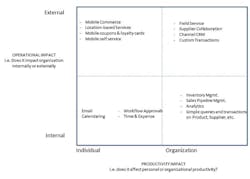Smartphones have become a big part of our personal lives and have changed the way we communicate with our friends, shop, or entertain ourselves. New McKinsey research highlights that nearly 50% of U.S. online consumers are now advanced users of smartphones, social networks, and other emerging tools -- up from 32% in 2008. This is a dramatic increase in the intensity with which people use these devices and platforms.
Smartphones are becoming the device of choice for e-mail, Web browsing, and product research. A third of smartphone owners prefer using mobile devices even when they are near PCs for Web browsing or e-mail.
Over the past two years, iPhone users have spent 45% more time e-mailing on their smartphones and 15% less time e-mailing on their PCs. More than 60% of smartphone users would consider buying goods with it or have already done so.
Clearly, such a preference in use of mobile technology over traditional devices is expected to spill over into our work environment and influence the way we interact with our colleagues, customers and suppliers.
The use of smartphones in business environment will only accelerate. Historically, most executives have used their smart phones for email and calendaring. After all, many of us are addicted to our 'crackberries.'
Three Reasons Why Mobile Technologies will Hit the Business World
- Consumerization is driving demand from employees: According to a Gartner announcement, total worldwide smartphone sales in 2011 reached 472 million units and accounted for 31% of all mobile devices sales, up 58% from 2010. In addition, 66 million tablets were sold in 2011, led by iPad. To top it all, consumers have downloaded apps (over 30 billion apps from iTunes alone) to make their phones fun and easier to use. As these employees bring their smartphones to work, they are asking themselves "why can't our company provide some nice and slick apps for our devices that make us more productive at work."
- Improve collaboration and productivity: Companies can use mobile technologies and applications both internally as a collaboration and efficiency tool and externally to create stronger links with customers and business partners. In the process they can reduce costs and improve customer service levels (which drives recurring revenue), leading to higher margins - an important metric for small and mid-sized businesses who don't have the same access to credit markets as their larger competitors. Whether employees are travelling to meetings, out on sales calls, working from a client's site or from home anywhere on the globe, mobile devices can help them communicate, access information, and stay on top of issues that require their attention.
- Look bigger than the competition: As small businesses grow, their size begins to work against them. As a small business, they were able to stay close to their customers, be nimble and offer superior service, while still making respectable margins. These attributes are the source of their competitive advantage. But as they grow, they begin to get squeezed from both sides -- they can no longer be as flexible and personalized as the smaller competitors, but at the same time, they don't have the scale to win business from larger customers.
To address this shortcoming, mid-size businesses must be seasoned in all of their customer interactions -- from marketing campaigns, to sales force's interactions with customers, to after-sales support and service. By deploying a combination of mobile technology and enterprise business systems, mid-sized companies can become operationally sophisticated and look bigger than their competition and in the process, win business from large customers.
Building a Successful Mobile Strategy
These three reasons make a compelling case for small and mid-size companies to invest in mobile technology. However these companies have limited IT budgets and resources and must approach their investment in mobile technology in a well thought out manner -- starting with small steps, gaining early wins and building upon them, while ensuring the chosen strategy is in alignment with their desired business outcomes.
The framework below (source: SAP analysis) provides a starting point on what type of apps to start with based on their operational and productivity impact and your desired business outcomes:
The business should first address employee productivity needs with email, calendaring, workflow approvals and simple transactions such as inventory management, analytics, sales pipeline management etc. Many of these capabilities may be available from their ERP vendor and may come pre-packaged with the application.
Since these applications are internal facing and have lower complexity, they enable the company to get their feet wet with mobile technology with low risk and cost. Once they get early successes, they can then deploy customer and supplier facing applications -- choices vary based on the type of business (consumer or B2B), the areas where impact to business may be high and their ability to deploy custom mobile applications.
For example, for a B2C business, top left hand quadrant may be an important area to explore. Supplier collaboration channel management and customer service apps instead may be the next set of apps for a B2B company to deploy.
Evaluating Your Mobile Technology
As you evaluate technologies to enable your mobile strategy, the first thing you should ensure that they work with your ERP system, so you can take advantage of existing systems and simply extend to mobile world -- without having to build new systems.
The technology should support the various types of mobile devices your employees use. You should also be able to scale to meet the increase in transaction volume you will begin to see over the next few years as you increase the scope of capabilities being addressed via mobile devices.
Your vendor should be able to provide you with a comprehensive solution that includes apps, device management, app management, and security, so do not have to deploy multiple vendor solutions and worry about integrating them yourself. It may not seem important now, but this may save a ton of time and money down the road, as you scale.
It also becomes important that your vendor has an ecosystem that can open a window into a world of third party apps and services to address your individual needs.
Finally, your mobile technology should also enable you to create custom applications as you get to that phase, as well as provide the right level of security, so your employees can only see the information they are authorized to access using the apps.
One thing's for certain: mobile technology is becoming more pervasive in the work place. Hence, small and mid-sized businesses can't afford to postpone it as they need to keep up with larger companies.
Though they have limited resources, by ensuring they get early successes with simple collaboration and productivity apps, and then aligning their deployment path with their business strategy, small and mid-sized businesses can successfully deploy mobile technology to level the playing field and even gain competitive advantage, when competing for the business of large customers.
Hande Bolukbasi is a Director in the Global Ecosystem & Channels Product Marketing Group at SAP and is responsible for mobile solutions.




